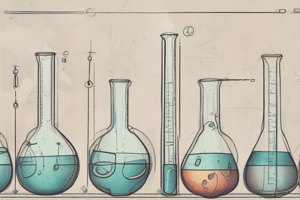Podcast
Questions and Answers
Mass percentage of a component (w/w) is given by the formula: Mass of component in solution = __________ × 100 / Total mass of solution.
Mass percentage of a component (w/w) is given by the formula: Mass of component in solution = __________ × 100 / Total mass of solution.
Mass of component
Volume percentage of a component (v/v) is calculated using the formula: Volume of the component = __________ × 100 / Total volume of solution.
Volume percentage of a component (v/v) is calculated using the formula: Volume of the component = __________ × 100 / Total volume of solution.
Volume of solution
What is the formula for mole fraction of a component?
What is the formula for mole fraction of a component?
Number of moles of the component / Total number of moles of all components
How is parts per million calculated?
How is parts per million calculated?
What is the formula for molarity?
What is the formula for molarity?
What formula expresses molality?
What formula expresses molality?
What does normality represent?
What does normality represent?
According to Raoult’s law, what is the relationship between partial vapor pressure and mole fraction?
According to Raoult’s law, what is the relationship between partial vapor pressure and mole fraction?
Which of the following equations include the van’t Hoff factor?
Which of the following equations include the van’t Hoff factor?
What is the formula for the change in boiling point (∆Tb)?
What is the formula for the change in boiling point (∆Tb)?
What is the equation for the change in freezing point (∆Tf)?
What is the equation for the change in freezing point (∆Tf)?
Flashcards are hidden until you start studying
Study Notes
Mass Percentage
- Mass percentage of a component is calculated by dividing the mass of the component by the total mass of the solution, and then multiplying by 100.
Volume Percentage
- Volume percentage of a component is calculated by dividing the volume of the component by the total volume of the solution, and then multiplying by 100.
Mole Fraction
- Mole fraction of a component is calculated by dividing the number of moles of the component by the total number of moles of all components in the solution.
Parts Per Million
- Parts per million (ppm) is a way to express the concentration of a component in a solution, specifically when the component is present in very small amounts.
Molarity
- Molarity (M) is a unit of concentration that represents the number of moles of solute per liter of solution.
Molality
- Molality (m) is a unit of concentration that represents the number of moles of solute per kilogram of solvent.
Normality
- Normality (N) is a unit of concentration that represents the number of gram equivalents of solute per liter of solution.
Relative Lowering of Vapour Pressure
- The relative lowering of vapor pressure is the difference between the vapor pressure of the pure solvent (p1o) and the vapor pressure of the solution (p1), divided by the vapor pressure of the pure solvent.
Elevation of Boiling Point
- The magnitude of the elevation in boiling point (∆Tb) is directly proportional to the molal concentration of the solute.
Depression of Freezing Point
- The lowering of freezing point (∆Tf) is proportional to the molality of the solution.
Osmotic Pressure
- Osmotic pressure (π) is the pressure that must be applied to a solution to prevent the inward flow of water across a semipermeable membrane.
Van't Hoff Factor
- The van't Hoff factor (i) is a measure of the extent to which a solute dissociates or associates in a solution.
Raoult's Law
- Raoult's law states that the partial vapor pressure of each component in a solution is directly proportional to its mole fraction.
Studying That Suits You
Use AI to generate personalized quizzes and flashcards to suit your learning preferences.




